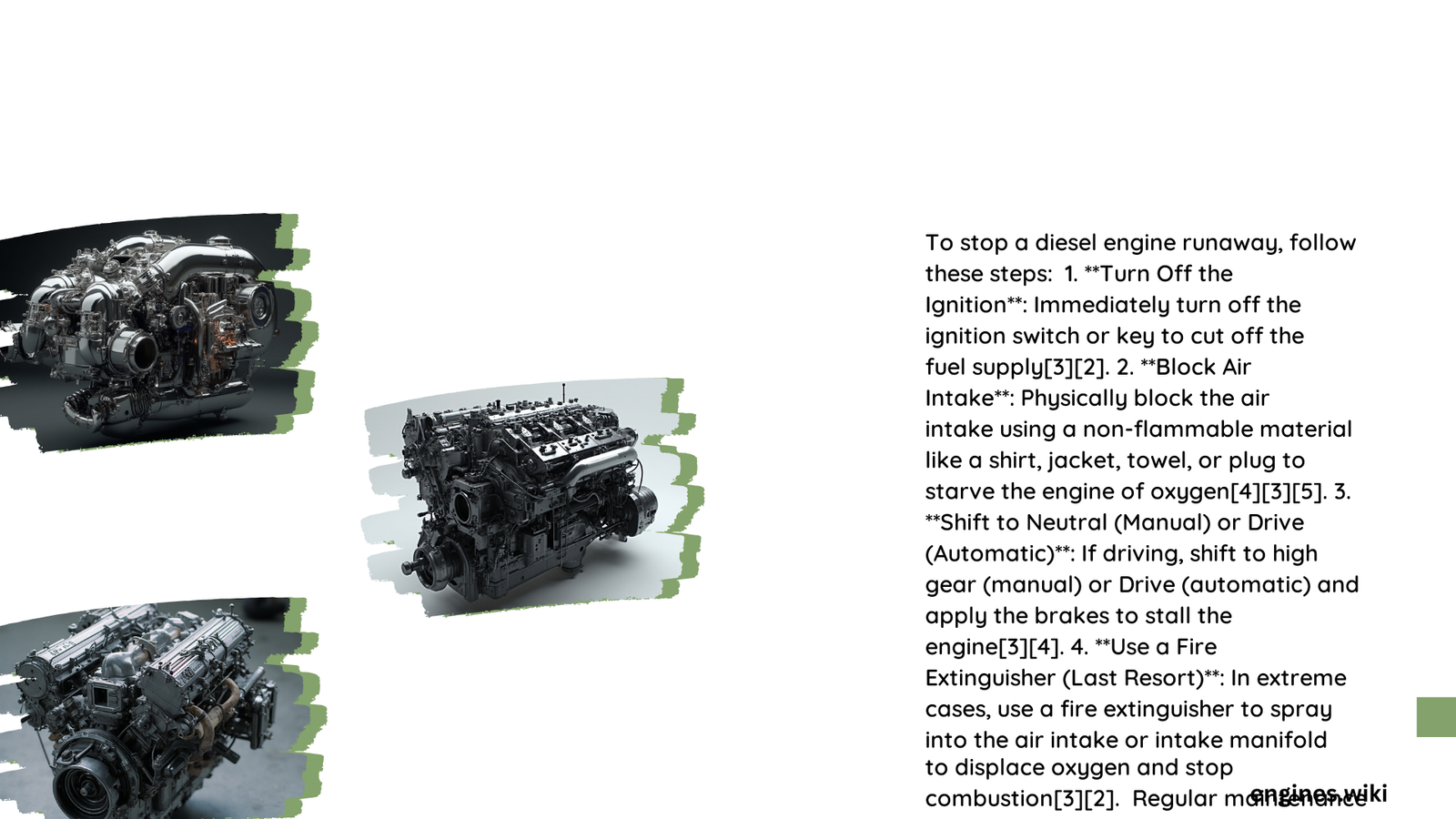Diesel engine runaway is a dangerous phenomenon where the engine continues to accelerate uncontrollably, potentially leading to catastrophic failure. This comprehensive guide explores the causes, symptoms, prevention techniques, and emergency stop procedures for diesel engine runaway. Understanding these aspects is crucial for operators and mechanics to ensure safety and prevent costly damage to engines.
What Causes Diesel Engine Runaway?
Diesel engine runaway occurs when the engine draws an external fuel source, causing it to accelerate beyond its normal operating speed. This can happen due to various mechanical and environmental factors:
Mechanical Causes:
- Oil or hydrocarbon seepage into the combustion chamber
- Turbocharger failure
- Fuel system faults
- Crankcase oil vapor entering the combustion chamber
Environmental Causes:
- Presence of combustible vapors in the surrounding air
- Hydrocarbon vapor clouds in industrial settings
What Are the Symptoms of Diesel Engine Runaway?

Recognizing the signs of a runaway diesel engine is crucial for quick action:
- Uncontrollable engine revving
- Rapid increase in engine speed without corresponding vehicle acceleration
- Excessive exhaust smoke (often black or white)
- Unusual and loud engine noises
There’s no specific RPM threshold that defines a runaway, but the engine typically overspeeds significantly, often producing up to ten times its rated output.
How Can Diesel Engine Runaway Be Prevented?
Prevention is key to avoiding the dangers of diesel engine runaway. Here are some effective strategies:
Regular Maintenance:
- Adhere to strict maintenance schedules
- Check and replace worn seals, piston rings, and other critical components
- Ensure proper functioning of the crankcase ventilation system
Quality Components:
- Use high-quality turbochargers and fuel injectors
- Regularly inspect and maintain the fuel system
Recommended Modifications:
- Install automatic diesel engine overspeed protection systems
- Implement advanced monitoring systems for early detection of potential issues
What Are the Emergency Stop Procedures for Diesel Engine Runaway?
In the event of a diesel engine runaway, quick action is crucial. Follow these steps:
- Block the Air Intake:
- Use a cover or plug to physically block the air intake
-
Alternatively, direct a CO2 fire extinguisher into the air intake
-
Operate the Decompressor:
-
If the engine is equipped with a decompressor, activate it to help slow the engine
-
Manual Transmission Method (Last Resort):
- In a vehicle with manual transmission:
- Engage a high gear (4th, 5th, or 6th)
- Apply foot brake and parking brake
- Quickly release the clutch to slow engine RPM
- Warning: This method can cause severe transmission damage
Timing Considerations:
Act swiftly, as the situation can escalate rapidly, leading to significant engine damage or explosion.
Essential Tools for Emergency Stop:
- CO2 fire extinguisher
- Air intake block or plug
- Decompressor (if fitted)
- Manual transmission (if applicable)
What Are the Long-term Consequences of Diesel Engine Runaway?
Diesel engine runaway can have severe consequences if not addressed promptly:
- Engine Destruction: The extreme RPMs can cause internal components to fail catastrophically.
- Fire Hazard: Overheating and oil leaks can lead to engine fires.
- Environmental Impact: Uncontrolled emissions during runaway can be harmful to the environment.
- Economic Loss: The cost of replacing a destroyed engine can be substantial.
How Does Engine Design Influence Runaway Risk?
The design of diesel engines plays a crucial role in their susceptibility to runaway:
| Design Feature | Impact on Runaway Risk |
|---|---|
| Turbocharging | Increases risk due to potential oil leaks |
| Direct Injection | Can mitigate risk with precise fuel control |
| Electronic Control Systems | Offer better monitoring and shutdown capabilities |
| Crankcase Ventilation | Proper design reduces oil vapor ingestion risk |
What Role Does Operator Training Play in Preventing Runaway?
Proper operator training is essential in preventing and managing diesel engine runaway:
- Recognition: Train operators to quickly identify runaway symptoms.
- Emergency Procedures: Ensure all operators know the correct emergency stop procedures.
- Maintenance Awareness: Educate on the importance of regular maintenance checks.
- Environmental Awareness: Train operators to be mindful of potentially hazardous environments.
How Do Modern Technologies Help in Runaway Prevention?
Advancements in technology have introduced new ways to prevent and manage diesel engine runaway:
- Electronic Fuel Injection Systems: Provide precise control over fuel delivery, reducing the risk of overspeeding.
- Engine Control Units (ECUs): Monitor engine parameters and can initiate emergency shutdowns.
- Automatic Overspeed Protection: Systems that automatically cut fuel supply or air intake in case of detected overspeed.
- Advanced Sensors: Detect abnormal conditions like oil leaks or excessive RPM early.
What Industries Are Most at Risk for Diesel Engine Runaway?
Certain industries face a higher risk of diesel engine runaway due to their operating environments:
- Oil and Gas: Presence of combustible vapors in drilling and refining operations.
- Mining: Underground environments with potential for methane gas presence.
- Marine: Enclosed engine rooms and potential for oil leaks.
- Construction: Dusty environments that can affect air intake systems.
- Power Generation: Continuous operation of large diesel generators.
Understanding the specific risks in these industries helps in implementing targeted prevention strategies.
By comprehensively addressing these aspects of diesel engine runaway, operators and mechanics can significantly reduce the risk of this dangerous phenomenon, ensuring safer and more reliable engine operation across various industries.
